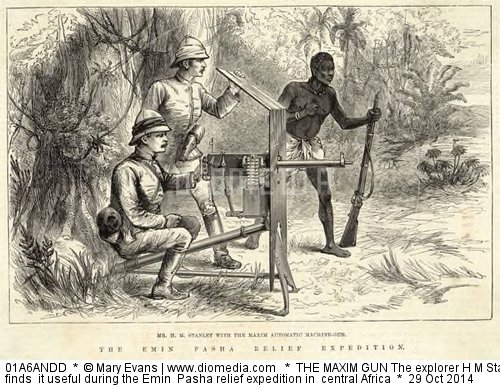Who Was the First Victim of a Machine Gun? October 30, 2014
Author: Beach Combing | in : Modern , trackbackThe machine gun was one of the most vicious military innovations of the late nineteenth century; and in the twentieth century, it slaughtered more individuals than the motor car, Ebola and ISIS put together. However, who had the honour of being first penetrated and killed by a machine gun bullet? The answer depends, of course, on what you define as a machine gun. If you choose the Gatling the answer is an American soldier in the Civil War, if you think of the Montigny mitrailleuse then there were some unlucky Prussians in the Franco-Prussian war… However, most military historians would choose, instead, the Maxim (no hand crank, automatic reloading etc…) as the first machine gun, and the Maxim gun became viable only in 1884. Forget then the Yankees and French-haters with pickelhauben, and look, instead, for events in the last fifteen years of the nineteenth century. Forget too the text books that point to the Russo-Japanese war, 1904-1905. By then hundreds had been sent to their maker by the Maxim, particularly in colonial conflicts. However, the very, very first? Well, in 1887 the Emin Pasha Relief Expedition set off from Zanzibar under Henry Stanley. There are two relevant machine gun facts about this expedition. 1) they took a Maxim gun with them (presented by Maxim himself): it took five men to carry all the parts. And 2) their gunner Stairs, known as Muzungu (‘he of the machine gun’) certainly used the Maxim. We cannot be sure that Stairs killed anyone. So to rely on his own dairy: 16 Jun 1887 Stairs was ready to murder some natives with the maxim but didn’t; 18 September 1887 two belts of ammunition were fired off for the ‘edification’ of natives (i.e. to intimidate them); 27 August 1887 Stairs fired his maxim at tribesmen on the other side of a river, ‘they dispersed at once amid yells’…. There is no record of deaths here: unless, of course, Stairs was so blase about killing Africans that he didn’t record them (having read his diary this is not impossible). But there were certainly deaths after Stairs had departed. When, in late September 1888, Stanley headed home, he and his party were set upon by local tribesmen to the west of Shinyanga. After Stanley himself was almost cut down he called out the Maxim and things got ‘interesting’. His companion, Mounteney-Jephson reported that ‘a great many dead [were left] on the field’ and that a pile of heads were cut from bodies and made into a pile in the camp. We are squarely in modern Tanzania here. It is very possible, then, that the first victim of the Maxim gun was ‘Tanzanian’ and looking at local tribal geography Bantu. Wonder if the proud warriors choking on their own blood were aware of the rare distinction they had just been given? Other proof about early machine gun deaths: drbeachcombing AT yahoo DOT com
30/Oct 2014: Mike L has a truly amazing link from an eighteenth century proto machine gun
29 Nov 2014: Ben writes in ‘Your post reminded me of my own researches into that period of history and the odd array of high-tech death-machines that the colonial armies took with them to combat groups of scared men with sticks. The late nineteenth century was a period of exuberant technological innovation in the field of firearms and artillery, a time when no systems had really emerged as definitively effective. You can see this in the fact that the Union Army of the US Civil War used about 15 different models of rifle, all of which used unique and often quite eccentric breech mechanisms. A few years ago I had to write a series of articles on 19th century Russian colonial expansion in Central Asia. The military campaigns in question started in around 1840 and took place every five to ten years until 1881 when the southern frontier was closed. The Russian armies that ventured into the Kazakh Steppe and beyond were equipped with a bizarre assortment of weaponry over the years. The Imperial Russian Army always had a magpie-like approach to procurement, and the desert was seen as a good place to test prototypes and small batches of new hardware. They used various kinds of congreve-style rocket over the years, and didn’t seem to mind that they were so inaccurate as to be entirely useless. The infantry were armed with a mixture of Crimean War-era rifle-muskets and odd experimental breech-loaders, while the officers all carried privately purchased Winchester repeaters. I was never able to pin down when exactly they started using Gatling guns — old professional soldiers tended to be somewhat squeamish about such weapons and avoided mentioning them unless they had to. But by the 1880 expedition they were undoubtedly part of their kit. No one seems to have liked them much. They were manned by Navy personnel for some reason and organised into batteries with the artillery. When researching the 1880 expedition I kept coming across passing references a rapid fire weapon that didn’t sound like a Gatling. It was bigger, had a gun shield, and may or may not have been taken from a river gunboat on the Caspian Sea. The only clue to its identity was a bad early 20th century translation of a Russian officer’s memoir that called it “the Hotchkiss”. This raises two possibilities, the first is that the translator was thinking of the M1909 Hotchkiss machine gun and using the term generically in the same way that the original author probably called it a Митралье́за, or “Mitrailleuse”. The second is that the Russians were using a Hotchkiss Revolving Cannon – a bizarre multiple-barrelled steampunk-looking attempt to make a 37mm autocannon – against unarmoured infantry, which seems a bit unsporting,a even for that era.’ Thanks Ben



